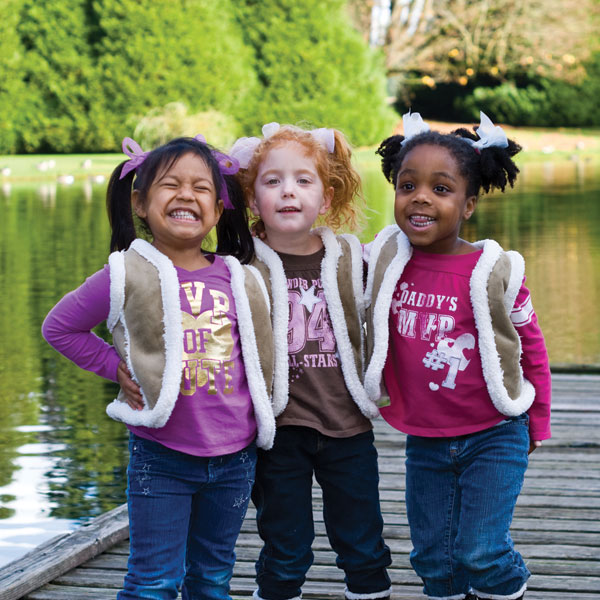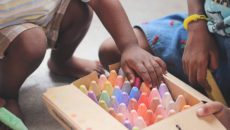Your preschooler has a magnificent ability. Given the opportunity, her mind can conjure imaginary playmates and talking animals. She can find creative uses for empty boxes and old sheets. This ability to pretend, which began around age two, is now in full bloom and can entertain her for hours.
Elaborate imaginary play offers more than just fun. It can hone problem-solving skills, lengthen attention span, and assist in emotional growth. Because a child expresses feelings through role-playing, pretending can even have cathartic or healing effects.
Preschoolers may naturally use play to explore topics, like birth or adoption, that they wouldn’t be ready to have a complex conversation about. What is behind some of the common play scenarios that young children engage in, and how can a parent respond?
Pretending to be Born
Your three-year-old’s favorite game is pretending that she’s being born from your tummy. She hides under your dress or a blanket on your lap, then jumps out, saying “I’m here!” at which you must repeatedly exclaim, “Oh, what a beautiful baby!” Sometimes, though, you wonder if it’s confusing or strange to play this game.
Relax. Pretending to be born is a common game at this age, for adopted and non-adopted children, and is not cause for concern. Until children can truly comprehend biology and reproduction, at around age six or seven, they can’t grasp the idea of having a birth mother. Rather than expressing sadness or confusion about who gave birth to her, a preschooler who plays this game is more likely expressing a wish to be close to you, the mother she knows and loves. Just as we don’t tell children they are not really doctors or cowboys when they pretend, there’s no reason for an adopted child not to play “being born” with you, her mother.
After the next session of “being born,” you can gently reinforce your child’s adoption story by saying, “That was fun! Now, let me tell you about the first time I saw you.”
Acting Like a Baby
Your three-year-old is spirited and independent at preschool and on the playground — he can tie his own shoes and scramble to the top of the monkey bars. But when he’s at home in the evenings, he often wants to be treated like a baby. He likes to snuggle in your lap as much as possible, protests moving from his crib to a “big boy bed,” and can’t fall asleep without his nighttime bottle.
Psychologists tell us that some children regress in order to calm themselves or to regain control. Still, it can be hard for parents when regressive behaviors come just as we’ve gotten past the “terrible twos,” and when pediatricians are telling us to throw away the bottles. And parents may wonder, Does my child want to be treated like a baby to recreate and mend her past, or simply because she likes to be babied?
Any toddler, adopted or not, may want to return to the nurturing rituals of infancy before her feels ready to step into the next phase of his life, particularly during a very real life transition, like entering preschool or gaining a new little sister or brother.
If your child seems “stuck” in a regressive period, you may want to seek outside help. But babyish behaviors often disappear without our learning their cause. Our job is less to wonder why than to provide strong arms and a warm lap to hold them — until they’re ready to move on.
Playing Adoption
Your five-year-old rarely asks questions about adoption, and you suddenly realize it’s been a while since you last told her her story.
Rather than try to open up an adoption conversation with your reticent preschooler, find ways to weave parts of her story into play or other activities. Playing can let you provide information gently and naturally, and can pave the way to talking. You might:
– Choose a few stuffed animals and tell your child, “Teddy bear can’t live with his birth family. Do you think Duck and Dinosaur should adopt him and love him?”
– Tell your child, “When we heard you were born, we drove through the night to meet you.” Pretend to travel to meet him, with sound effects, then tell him about the first time you saw him at the hospital. Don’t hold back when reenacting your joy at your first meeting.
– Scatter pieces of construction paper into a curvy path, and say, “This road leads us to your birthplace in Russia. What do you think we’ll see on the way? When we’re there?”
– When you’re drawing or painting together, suggest, “Shall we draw the airplane Mommy and Daddy got on to adopt you?” or “What do you think your birth mother looks like? Let’s paint her picture.”
After you’ve set the theme, however, follow your child’s lead during playtime, and let him make up the rules. Preschoolers need to direct play in order to learn from it and process new information.

